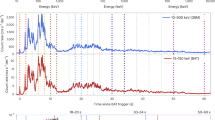Abstract
THE essentially isotropic distribution of the Vela satellite γ-ray bursts1 implies that the sources are either very local and galactic, or very remote and extragalactic. Of the theories for a remote origin there are two schools of thought, either that these γ-rays originate in shock waves during the formation of type II supernovae2 or that they represent transient pulses of blackbody emission associated with the collapse of a white dwarf to a neutron star3.
This is a preview of subscription content, access via your institution
Access options
Subscribe to this journal
Receive 51 print issues and online access
$199.00 per year
only $3.90 per issue
Buy this article
- Purchase on Springer Link
- Instant access to full article PDF
Prices may be subject to local taxes which are calculated during checkout
Similar content being viewed by others
References
Klebesadel, R. W., Strong, I. B., and Olson, R. A., Astrophys. J. Lett., 182, L85 (1973).
Colgate, S. A., Early γ rays from supernovae in Proc. Los Alamos Conference (in the press).
Ramaty, R., and Cohen, J. M., Goddard Preprint X-660-73-326 (1973).
LeBlanc, J. M., and Wilson, J. R., Astrophys. J., 161, 541 (1970).
Strong, I. B., Klebesadel, R. W., and Olson, R. A., Astrophys. J. Lett., 188, L1 (1974).
Cline, T. L., Desai, U. D., Klebesadel, R. W., and Strong, I. B., Astrophys. J. Lett., 185, L1 (1973).
Author information
Authors and Affiliations
Rights and permissions
About this article
Cite this article
JELLEY, J. Interpretation of double structure in the celestial γ-ray bursts. Nature 249, 747–748 (1974). https://doi.org/10.1038/249747a0
Received:
Issue Date:
DOI: https://doi.org/10.1038/249747a0
Comments
By submitting a comment you agree to abide by our Terms and Community Guidelines. If you find something abusive or that does not comply with our terms or guidelines please flag it as inappropriate.



